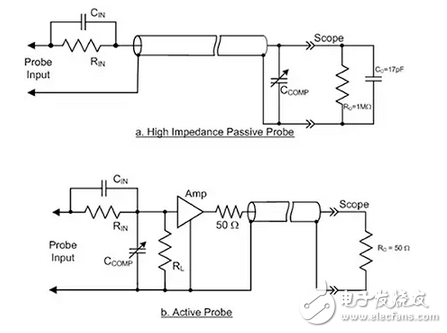
资料下载

理解、选择和有效地使用有源示波器探头
理解、选择和有效地使用有源示波器探头
编者按:这篇关于主动探针的文章是关于探针及其正确使用的三部分系列文章的第二部分。第1部分:高阻无源探头。本文将讨论单端、差分和高压差分有源探头。第3部分将处理当前的探针。
有源探头比被动探头提供更大的带宽和更低的输入电容。在这篇文章中,有源探头相对于被动探头的特性将被证明。将研究单端和差分探头,同时适当使用探头附件。
为什么使用主动探针?
无源探头非常适合于带宽小于50 MHz的测量应用。这是因为无源探头有9或10皮法范围的输入电容(pF)。这可以加载正在测试的设备。这些加载效应随频率的增加而增加。为了避免这种负载效应,有源探头在无源探头的补偿衰减器和示波器输入之间插入一个放大器(图1)。

The amplifier buffers the connecting cable and allows the cable to be terminated into its characteristic impedance, which is nominally 50 W. This isolates the probe from the capacitive loading of the cable and the input circuitry of the scope. The amplifier is designed to minimize input capacitance, with 4 pF being a nominal value. The compensated attenuator further reduces this capacitance. For a 10:1 attenuation, the expected input capacitance is about 0.4 pF. However, input protection circuitry and probe tip hardware add additional capacitance.
A typical active probe, the Teledyne LeCroy ZS1000 1 GHz single-ended active probe offers an input capacitance of 0.9 pF and an input resistance of 1 MW.
声明:本文内容及配图由入驻作者撰写或者入驻合作网站授权转载。文章观点仅代表作者本人,不代表电子发烧友网立场。文章及其配图仅供工程师学习之用,如有内容侵权或者其他违规问题,请联系本站处理。 举报投诉
- 相关下载
- 相关文章







